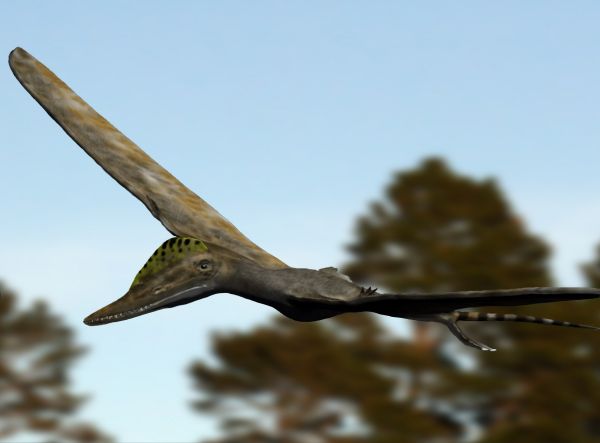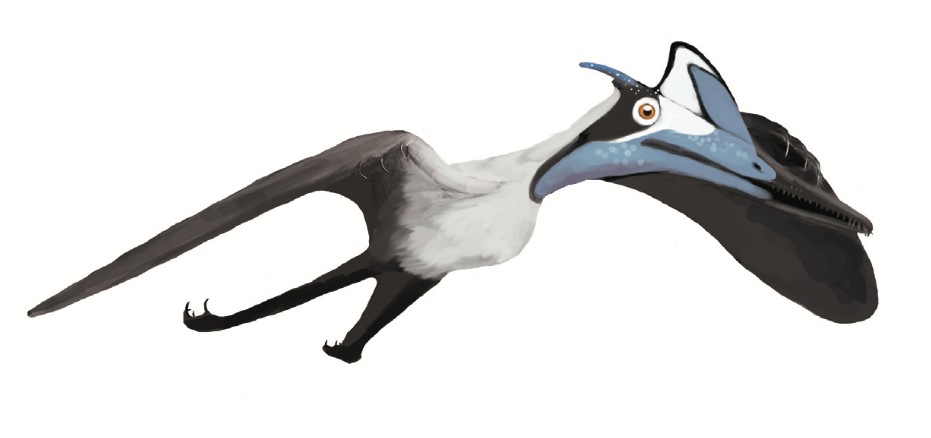|
Wukongopterid
Wukongopteridae is a group of basal pterosaurs, found in China and the UK. It contains eight species in five genera, all dated to the Middle to Late Jurassic period, The Wukongopteridae were first named by Wang ''et al.'' in 2009, not yet giving an exact definition.* The clade Wukongopteridae was first defined by Wang ''et al.'' in 2010 as "the most recent common ancestor of '' Wukongopterus lii'' and '' Kunpengopterus sinensis'', and all of its descendants". Description Wukongopterids are characterized by a unique combination of "primitive" and advanced pterosaurian features. While they had long tails and other features characteristic of other " rhamphorhynchoids", they also had distinct pterodactyloid features, such as long vertebrae in the neck and a single skull opening in front of the eyes, the nasoantorbital fenestra (in most "rhamphorhynchoids", the antorbital fenestra and the nasal opening are separate). This feature lead to ''Darwinopterus modularis'' being placed by ... [...More Info...] [...Related Items...] OR: [Wikipedia] [Google] [Baidu] |
Darwinopterus
''Darwinopterus'' (meaning "Darwin's wing") is a genus of pterosaur, discovered in China and named after biologist Charles Darwin. Between 30 and 40 fossil specimens have been identified, all collected from the Tiaojishan Formation, which dates to the middle Jurassic period, 160.89–160.25 Ma ago.Liu Y.-Q. Kuang H.-W., Jiang X.-J., Peng N., Xu H. & Sun H.-Y. (2012). "Timing of the earliest known feathered dinosaurs and transitional pterosaurs older than the Jehol Biota." ''Palaeogeography, Palaeoclimatology, Palaeoecology'' (advance online publication). The type species, ''D. modularis'', was described in February 2010. ''D. modularis'' was the first known pterosaur to display features of both long-tailed (" rhamphorhynchoid") and short-tailed ( pterodactyloid) pterosaurs, and was described as a transitional fossil between the two groups.Dell'Amore, C. (2009)"Odd New Pterosaur: 'Darwin's Wing' Fills Evolution Gap."''National Geographic News'', 13 October 2009. Accessed 14 October ... [...More Info...] [...Related Items...] OR: [Wikipedia] [Google] [Baidu] |
Kunpengopterus Sinensis
''Kunpengopterus'' is a genus of wukongopterid pterosaur from the middle-late Jurassic Tiaojishan Formation of northeastern China. The genus contains two species, the type species ''K. sinensis'' and ''K. antipollicatus''. History of discovery ''K. sinensis'' is known from the holotype specimen IVPP V16047, an almost complete skeleton with complete skull and lower jaws recovered from rocks of the Tiaojishan Formation in Linglongta, Jianchang County, western Liaoning. The age of these layers is controversial. This compression fossil is of an adult individual. Aside from the bones some soft parts were also preserved and the remains of a possibly regurgitated fish. ''Kunpengopterus'' was named and described by Wang Xiaolin, Alexander Wilhelm Armin Kellner, Jiang Shunxing, Cheng Xin, Meng Xi and Taissa Rodrigues in 2010. The type species is ''Kunpengopterus sinensis''. The generic name combines the Kun, a large fish or whale from Chinese folklore that could transform itself i ... [...More Info...] [...Related Items...] OR: [Wikipedia] [Google] [Baidu] |
Kunpengopterus
''Kunpengopterus'' is a genus of wukongopterid pterosaur from the middle-late Jurassic Tiaojishan Formation of northeastern China. The genus contains two species, the type species ''K. sinensis'' and ''K. antipollicatus''. History of discovery ''K. sinensis'' is known from the holotype specimen IVPP V16047, an almost complete skeleton with complete skull and lower jaws recovered from rocks of the Tiaojishan Formation in Linglongta, Jianchang County, western Liaoning. The age of these layers is controversial. This compression fossil is of an adult individual. Aside from the bones some soft parts were also preserved and the remains of a possibly regurgitated fish. ''Kunpengopterus'' was named and described by Wang Xiaolin, Alexander Wilhelm Armin Kellner, Jiang Shunxing, Cheng Xin, Meng Xi and Taissa Rodrigues in 2010. The type species is ''Kunpengopterus sinensis''. The generic name combines the Kun, a large fish or whale from Chinese folklore that could transform itse ... [...More Info...] [...Related Items...] OR: [Wikipedia] [Google] [Baidu] |
Archaeoistiodactylus
''Archaeoistiodactylus'' is an extinct genus of wukongopterid pterosaur from the Middle Jurassic of China. Discovery and naming ''Archaeoistiodactylus'' is known from an incomplete skeleton with a partial skull and lower jaws. Catalogued as holotype specimen JPM04-0008, it was recovered from rocks of the Tiaojishan Formation in western Liaoning, China, which date to the Bathonian-Callovian stages of the Jurassic period. Apart from the skull, it preserves ribs, parts of the wings, hindlimbs and the pelvis. The neck, tail and feet of the specimen are lacking. ''Archaeoistiodactylus'' was first named and described by Lü Junchang and Fucha Xiaohui in 2010. The type species is ''Archaeoistiodactylus linglongtaensis''. The generic name is a combination of the Greek ''archaios'', "ancient", with the name of the genus ''Istiodactylus'', referring to ''Archaeoistiodactylus'' being presumed to have been an older close relative of the latter. The specific name refers to the provenance near ... [...More Info...] [...Related Items...] OR: [Wikipedia] [Google] [Baidu] |
Monofenestrata
Monofenestrata is a clade of pterosaurs. It includes the pterosaurs in which the nasal and antorbital fenestra (openings/holes) in the skull are merged into a single fenestra. The clade includes the pterodactyloids and their close relatives. Classification The clade Monofenestrata was in 2010 defined as the group consisting of ''Pterodactylus'' and all species sharing with ''Pterodactylus'' the synapomorphy of an external nostril confluent with the antorbital fenestra, the major skull opening on the side of the snout. The name is derived from Greek ''monos'', "single", and Latin ''fenestra'', "window". The concept was inspired by the discovery of '' Darwinopterus'', a species combining a pterodactyloid-type skull with a more basal build of the remainder of the body. The Darwinoptera, a primitive subgroup of monofenestratans showing this transitional anatomy, was also named for ''Darwinopterus'' and defined as all descendants of its common ancestor with '' Pterorhynchus''. Belo ... [...More Info...] [...Related Items...] OR: [Wikipedia] [Google] [Baidu] |
Changchengopterus
''Changchengopterus'' is a genus of non-pterodactyloid pterosaur from Qinglong County in Hebei Province, China. Discovery and naming The fossil specimen, holotype CYGB-0036, of the type and only species, ''Changchengopterus pani'', was found in the Tiaojishan Formation dating from the Callovian and named and described by Lü Junchang in 2009. The generic name combines the ''Changcheng'', the Great Wall of China, with a Latinised Greek ''pteron'', "wing". The specific name honours Pan Lijun, who collected the fossil and donated it to science. The holotype, a skeleton lacking the skull, represents a young juvenile, of which the combined paired wing elements measure just seventeen centimetres.Lü, J. (2009). "A new non-pterodactyloid pterosaur from Qinglong County, Hebei Province of China." ''Acta Geologica Sinica'' (English Edition), 83(2): 189-199. . In 2011, a second specimen was described, PMOL-AP00010, acquired in 2008 by the Paleontological Museum of Liaoning. It consists o ... [...More Info...] [...Related Items...] OR: [Wikipedia] [Google] [Baidu] |
Wukongopterus NT
''Wukongopterus'' is a genus of basal pterosaur, found in Liaoning, China, from the Tiaojishan Formation, of the Middle or Late Jurassic. It was unusual for having both an elongate neck and a long tail. Discovery and naming The genus was described and named in 2009 by Wang Xiaolin, Alexander Kellner, Jiang Shunxing and Meng Xi. The genus name is derived from Sun Wukong, the Monkey King, the main hero of the Chinese classic novel ''Journey to the West'', and a Latinized Greek ''pteron'', "wing". The specific name honours Li Yutong, senior preparator of the Institute of Vertebrate Paleontology and Paleoanthropology (IVPP). The genus is based on holotype IVPP V15113, a nearly complete but compressed skeleton lacking the back and middle of the skull. The type individual appears to have broken its shin during life. Its wingspan is estimated at . ''Wukongopterus'' also may have had an uropatagium, a membrane between the hind legs. Classification Below is a cladogram followi ... [...More Info...] [...Related Items...] OR: [Wikipedia] [Google] [Baidu] |
Pterosaur
Pterosaurs are an extinct clade of flying reptiles in the order Pterosauria. They existed during most of the Mesozoic: from the Late Triassic to the end of the Cretaceous (228 million to 66 million years ago). Pterosaurs are the earliest vertebrates known to have evolved powered flight. Their wings were formed by a membrane of skin, muscle, and other tissues stretching from the ankles to a dramatically lengthened fourth finger. There were two major types of pterosaurs. Basal pterosaurs (also called 'non-pterodactyloid pterosaurs' or ' rhamphorhynchoids') were smaller animals with fully toothed jaws and, typically, long tails. Their wide wing membranes probably included and connected the hind legs. On the ground, they would have had an awkward sprawling posture, but the anatomy of their joints and strong claws would have made them effective climbers, and some may have even lived in trees. Basal pterosaurs were insectivores or predators of small vertebrates. Later pte ... [...More Info...] [...Related Items...] OR: [Wikipedia] [Google] [Baidu] |
Pterodactyloidea
Pterodactyloidea ( ; derived from the Greek words ''πτερόν'' (''pterón'', for usual ''ptéryx'') "wing", and ''δάκτυλος'' (''dáktylos'') "finger") is one of the two traditional suborders of pterosaurs ("wing lizards"), and contains the most derived members of this group of flying reptiles. They appeared during the middle Jurassic Period, and differ from the basal (though paraphyletic) rhamphorhynchoids by their short tails and long wing metacarpals (hand bones). The most advanced forms also lack teeth, and by the late Cretaceous, all known pterodactyloids were toothless. Many species had well-developed crests on the skull, a form of display taken to extremes in giant-crested forms like '' Nyctosaurus'' and '' Tupandactylus''. Pterodactyloids were the last surviving pterosaurs when the order became extinct at the end of the Cretaceous Period, together with the non-avian dinosaurs and most marine reptiles. " Pterodactyl" is also a common term for pterodactyloid pte ... [...More Info...] [...Related Items...] OR: [Wikipedia] [Google] [Baidu] |
Jurassic
The Jurassic ( ) is a Geological period, geologic period and System (stratigraphy), stratigraphic system that spanned from the end of the Triassic Period million years ago (Mya) to the beginning of the Cretaceous Period, approximately 143.1 Mya. The Jurassic constitutes the second and middle period of the Mesozoic, Mesozoic Era as well as the eighth period of the Phanerozoic, Phanerozoic Eon and is named after the Jura Mountains, where limestone strata from the period were first identified. The start of the Jurassic was marked by the major Triassic–Jurassic extinction event, associated with the eruption of the Central Atlantic magmatic province, Central Atlantic Magmatic Province (CAMP). The beginning of the Toarcian Age started around 183 million years ago and is marked by the Toarcian Oceanic Anoxic Event, a global episode of Anoxic event, oceanic anoxia, ocean acidification, and elevated global temperatures associated with extinctions, likely caused by the eruption of the Kar ... [...More Info...] [...Related Items...] OR: [Wikipedia] [Google] [Baidu] |
Cuspicephalus
''Cuspicephalus'' is an extinct genus of monofenestratan pterosaur known from Dorset in England. Its fossil remains date back to the Late Jurassic period. Discovery ''Cuspicephalus'' is known from the holotype MJML K1918, a partial skull which is missing the mandible and dentition, preserved on a single slab. It was collected in December 2009 by Steve Etches from Kimmeridge Bay on the Isle of Purbeck coast of Dorset. This locality is referred to the ''Autissiodorensis'' ammonite biozone of the lower part of the Kimmeridge Clay Formation, dating to the early Kimmeridgian stage of the Late Jurassic, about 155.7-153 million years ago. Naming and etymology ''Cuspicephalus'' was named by David M. Martill and Steve Etches in 2013 and the type species is ''Cuspicephalus scarfi''. The generic name is derived from ''cuspis'', Latin for "point", after its pointed rostrum, and a Latinised Greek κεφαλή, ''kephalè'', for "head". The specific name honors artist and cartoonis ... [...More Info...] [...Related Items...] OR: [Wikipedia] [Google] [Baidu] |







